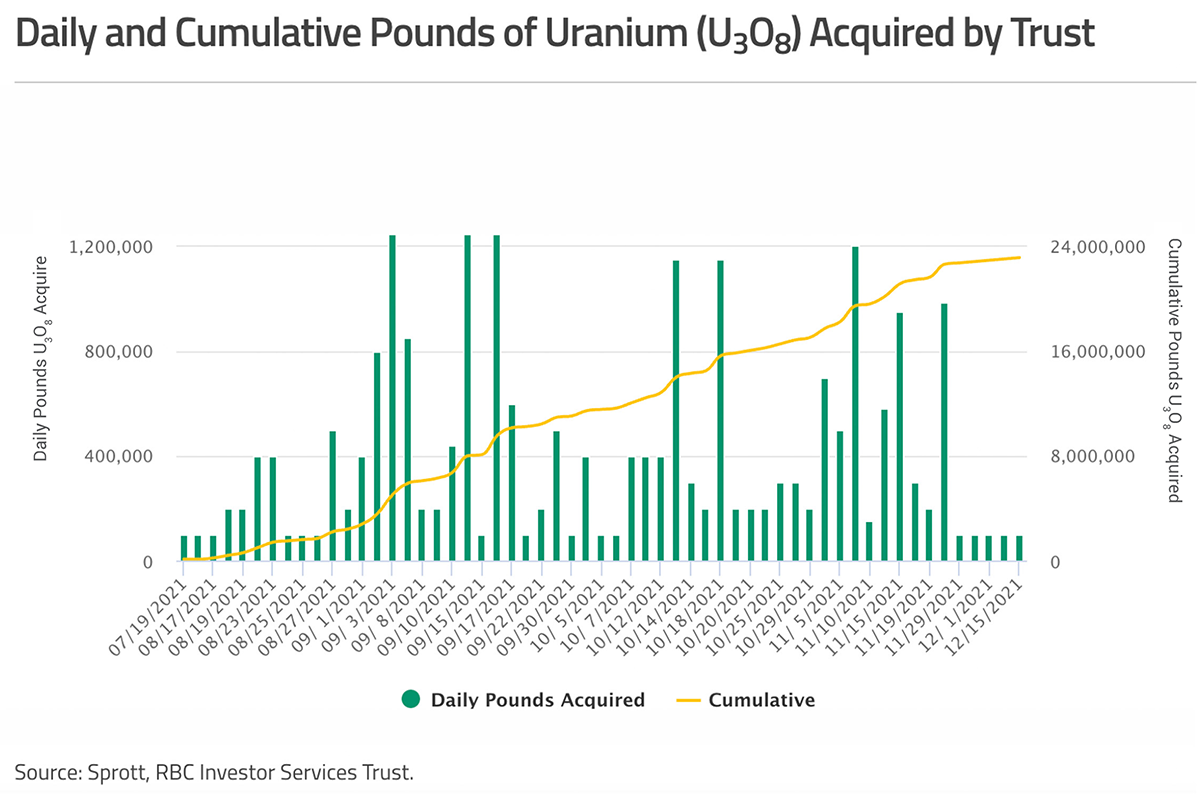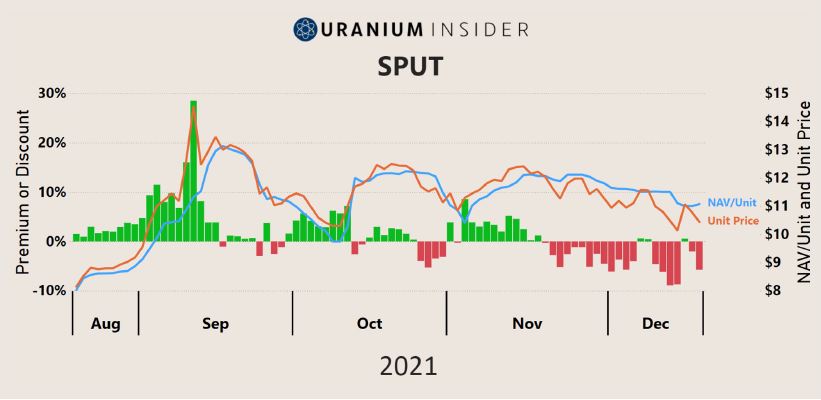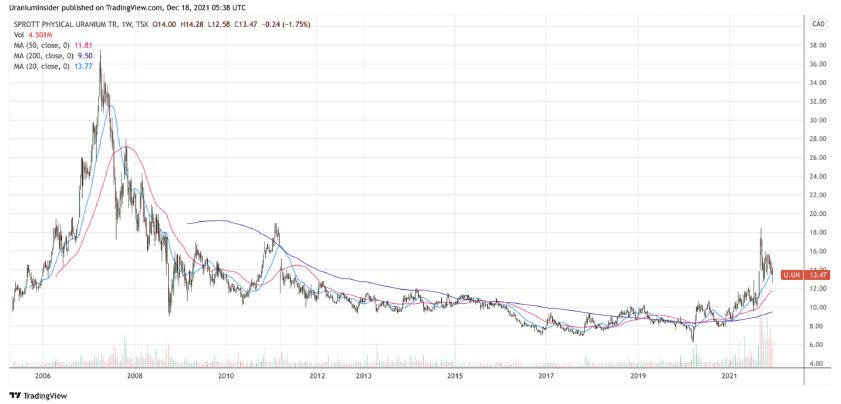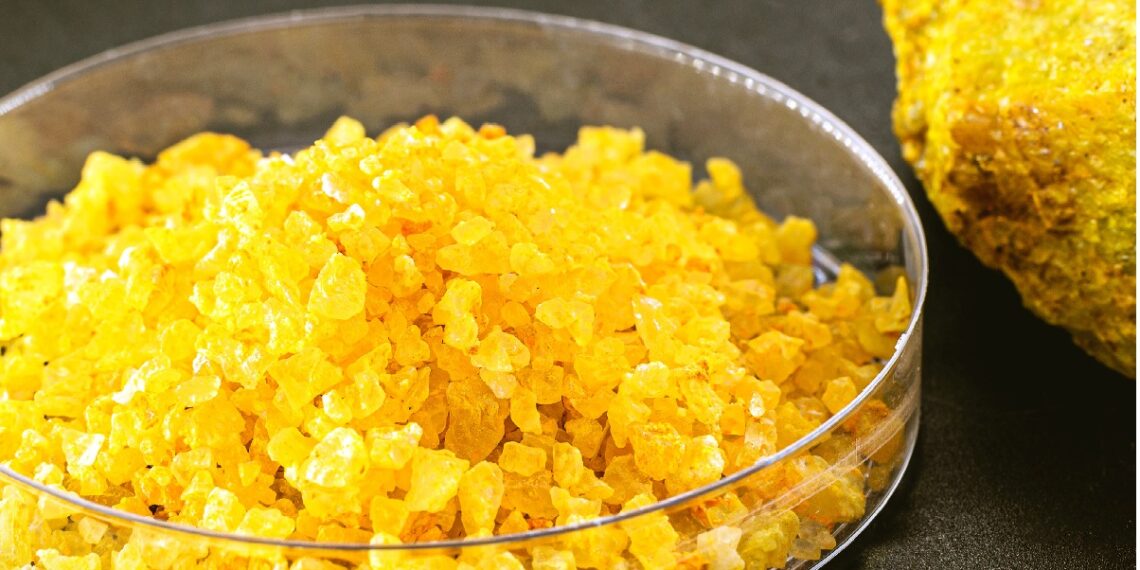In 2005 Uranium Participation Corp. (UPC) was launched and began trading on the Toronto Stock Exchange (TSX). The purpose of this entity was to purchase pounds of uranium and hold them for long-term appreciation in much the same way as SPDR Gold Shares (NYSE: GLD) acquires ounces of gold. The management contract for UPC was acquired in 2021 by Sprott Inc. (TSX: SII), and Sprott formally took over as the manager last July. Over its 16-year lifespan, UPC acquired 18.5M lbs of uranium. Sprott converted UPC from a corporate entity to a trust structure and renamed it the Sprott Physical Uranium Trust – aka “SPUT” (TSX: U.UN). In 2018, a similar vehicle, Yellow Cake plc (LSE: YCA) (see profile on p.66), was launched in London with the same objective. Yellow Cake launched with an interesting 10-year Framework Agreement with Kazatomprom (LSE: KAP) to acquire US$100M per year of uranium through to 2027.
Now, we return to SPUT and its dramatic impact on the uranium space in 2021. On 17 August 2021, SPUT activated its first in a series of At-the-Market (ATM) financings – a type of registration that essentially allows the issuer to issue new units of the Trust on a daily basis, as long as the Trust’s unit price is trading at a minimum of a 1% premium to Net Asset Value (NAV). In its first 5 ½ months, utilizing its ATM, it has purchased a massive 24.8M lbs of uranium (data as of 10 January, 2021). During this period SPUT raised US$1.1B in new investor capital solely with a TSX listing. Recently, SPUT filed the necessary paperwork to allow the Trust to take in a total of up to US$3.5B through its ATM. SPUT is pursuing a NYSE listing (and expects to file its application for listing in January 2022), and management anticipates being granted a listing by mid-2022.

Examine the chart above to view the remarkable accumulation of pounds over this short window – pounds that are now “sequestered” because SPUT’s Trust structure does not permit the sale of accumulated pounds.
To put this in perspective, the U.S., with the world’s largest operating fleet of 94 nuclear reactors, consumes just under 50M lbs of uranium (U3O8) per year. Each 1GW nuclear reactor consumes approximately 450,000 lbs of U3O8 per year. So, in just over five months, SPUT’s purchases have had the effect of an entire year’s uranium demand for 55 nuclear reactors.

As previously mentioned, SPUT’s Trust structure does not permit issuance of newly issued Trust units unless they are issued at a minimum of 101% of NAV for the new issuance to not be dilutive to pre-existing Trust owners. As you see in the chart overleaf, SPUT had been trading at a discount to NAV for much of December 2021, preventing SPUT from taking in new capital through new ATM issuance and the further large-scale acquisition of pounds, but we expect that circumstance to reverse in the new year.
To get a better perspective of where the current uranium rally stands vs the prior bull run in the first decade of the new millennium, examine the long-term weekly chart below that includes SPUT and its predecessor UPC. The trading volume is noteworthy, as well… As mentioned above, SPUT is not the only physical acquisition entity. London-based Yellow Cake plc continues to pursue its business objective of accumulating pounds as well. Yellow Cake plc now holds 18.5M lbs of uranium. In November 2021 yet another physical acquisition entity was announced with initial sponsorship from the world’s largest producer, Kazatomprom. KAP announced that it was going to “seed” a new uranium physical acquisition entity called “ANU Energy” along with co-sponsors, the Central Bank of Kazakhstan, and an Emirati investment firm. The news release outlined the initial funding of US$50M as well as plans for a follow-on US$500M equity offering to be funded by Central Asian and Eastern investors. Anecdotal comments from Kazatomprom COO Askar Batyrbayev made it clear that the likelihood and success of this subsequent funding is very high.













